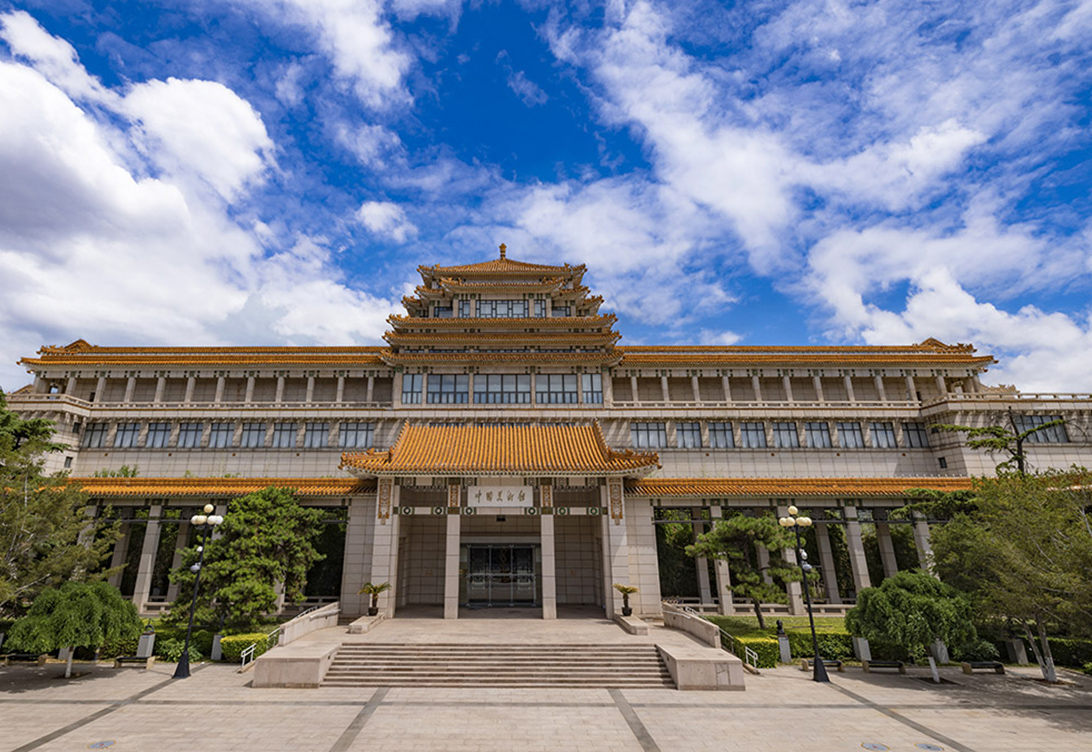History

As one of the nation’s most significant cultural landmarks, the National Art Museum of China (NAMOC) started its construction in 1958, and was officially opened in 1963, with the inscription of its name written by Chairman Mao Zedong. Its main building, roofed with yellow glazed tiles and surrounded by corridors and pavilions, features the styles of ancient Chinese attics and traditional architecture. The main building has a total land area of over 18,000 square meters with 21 exhibition halls on six floors. The museum boasts an exhibition area of 6,660 square meters in total. There is also a 3,000-square-meter sculpture park in the vicinity of the main building. In 1995, a new 4100-square-meter exhibit warehouse with high-tech facilities was added to the compound.
The NAMOC, China’s national art museum, serves as an important public platform for cultural services and a window for international art exchanges. It also shoulders the cultural responsibility of “promoting fine traditional culture, collecting masterpieces of art, strengthening international and domestic exchanges, boosting contemporary art creation, presenting the best of fine arts, and benefiting public cultural services.”
As the NAMOC celebrated its 60th anniversary on May 21, 2023, General Secretary Xi Jinping replied to a letter by veteran experts and artists of the NAMOC. He said in the letter that the NAMOC has witnessed New China’s thriving development of fine arts. Upholding fundamental principles and breaking new ground, it has achieved a great deal in collecting outstanding artworks, holding exhibitions, facilitating public education, and promoting international exchanges. The museum is expected to adhere to the correct political orientation, put people first and put into practice the core socialist values in running the museum. Painstaking efforts need to be made on the part of the museum to improve the quality of its collection, promote its utilization level of artworks, and provide better services. The museum should develop itself into an art venue that enjoys national and even worldwide prestige for the general public to appreciate fine artworks and improve their artistic literacy in the new era, so as to make greater contributions to the prosperity and development of China's fine arts, to building cultural confidence and strength, and to achieving new progress in developing socialist culture.
The NAMOC has preserved China’s cultural legacy and laid a solid foundation for its future development by collecting a large number of high-quality artworks. It now has a collection of over 130,000 artworks from ancient and modern times, both domestic and foreign, including those by renowned Chinese masters such as Su Shi, Ni Zan, Tang Yin, Xu Wei, Ren Bonian, Wu Changshuo, Huang Binhong, Qi Baishi, Xu Beihong, Lin Fengmian, Liu Haisu, Pan Tianshou, Jiang Zhaohe, Wu Zuoren, Li Keran, Dong Xiwen, and Wu Guanzhong. It also boasts collections from calligraphers like Yu Youren, Gao Ershi, Sha Menghai, and Qi Gong, as well as sculptures by Liu Kaiqu, Hua Tianyou, and Wang Linyi. The international collection includes artworks by Käthe Kollwitz, Pablo Picasso, Salvador Dalí, Ansel Adams, and Jean Cardo.
Thanks to its high-level utilization of artworks, the NAMOC is in its best position to demonstrate the Chinese spirit and promote the innovative development of fine arts in China. The museum has presented more than 5,500 art exhibitions of various kinds, which attests to the fact that China’s fine arts are brimming with vigor and vitality. In the new era, the museum has launched new exhibition series including “Beauty in the New Era,” “Promoting Chinese Spirit,” “Activization of Classic Collection,” “Invitational Academic Exhibition,” “Artworks Donated to NAMOC,” and “International Exhibition Exchange.” These exhibits have yielded wide-ranging social impact. Undertaking national thematic art projects, the NAMOC has organized the creation of large-scale sculptures such as “Flag” and “Long March Group Sculptures”, which uphold their original aspirations, forge inner strength and inspire our people. It is the first art museum in China to set up a national postdoctoral research workstation.
In response to the expectations of the people, the NAMOC promotes aesthetic education for all through high-quality services. Its public education brands, such as Shape Figures of the New Era, Director Guide Day, Masters’ Lectures on Art, Night at the NAMOC, New Year Blessings, and National Disability Assistance Day, are gaining popularity and participation among the public.
The NAMOC aims to leverage the role of art to contribute to the building of a community with a shared future for mankind by strengthening international cultural exchanges, and creating influential exhibition brands like Chinese Xieyi, the Silk Road International Alliance of Art Museums, and the BRICS Alliance of Art Museums and Galleries. With its director serving as the Secretary-General for both alliances and the alliances’ secretariats based in the museum, the NAMOC has been playing a leading role in strengthening the mechanism of the alliances. Besides, it has placed a number of sculptures highlighting the Chinese spirit in multiple countries, which has greatly promoted the global visibility of Chinese culture and its exchanges and mutual learning with other civilizations.
To meet the requirements for the development of the cultural sector, the NAMOC plans to construct a new building. With the strong support of General Secretary Xi Jinping and the Chinese Government, this new museum project has been made a key national project.
Under the guidance of Xi Jinping Thought on Culture and the leadership of the Ministry of Culture and Tourism, the NAMOC is committed to developing itself into an art venue that enjoys national and even worldwide prestige for the general public to appreciate fine artworks and improve their artistic literacy in the new era, so as to make greater contributions to the prosperity and development of China's fine arts, to building cultural confidence and strength, and to achieving new progress in developing socialist culture.
- Museum Overview
- History
- Directors
- Contact Us

